American’s new Chief Customer Officer Heather Garboden appeared on the Airlines Confidential podcast to highlight her airline’s “renewed focus on customer experience.”
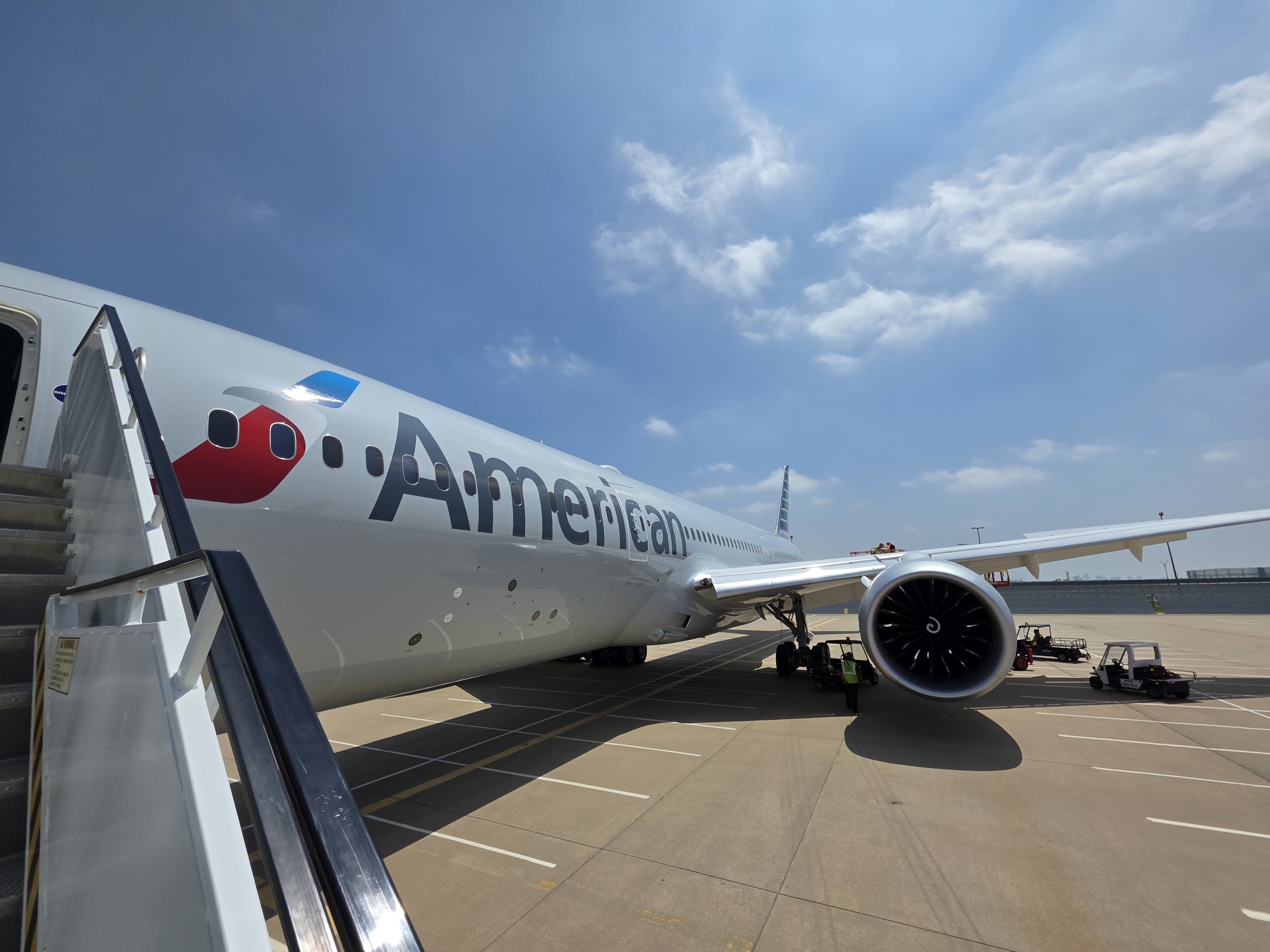
An America West veteran, she came up through the ranks of Doug Parker’s airline and has a background in finance and revenue management. That’s not what you’d obviously expect for someone picked to ‘represent the voice of the customer’ but it does mean that she knows the language and how to talk to the bean counters who have internalized CEO Robert Isom’s mantra not to ‘spend a dollar they don’t have to.’
She outlined her priorities as “everything.” There’s so much that needs to be done, but she’s starting with figuring out “the most important things…for our customer.”
- get insights from customers
- align the different parts of the airline – “commercial and operations, but also finance and corporate real estate and technology.”
And this cashes out first in what she’s calling “disruption management.” I hoped this would be ‘creative destruction’ since there are so many policies in place that need to be rethought at American. But she’s talking about improving things for customers during irregular operations. Still, we have seen the airline walk back its draconian changes to standby from last year. So that’s a good start.
There are actually a number of pieces of good news at American.
- New premium cabins. The new delivery Boeing 787-9Ps are gorgeous.
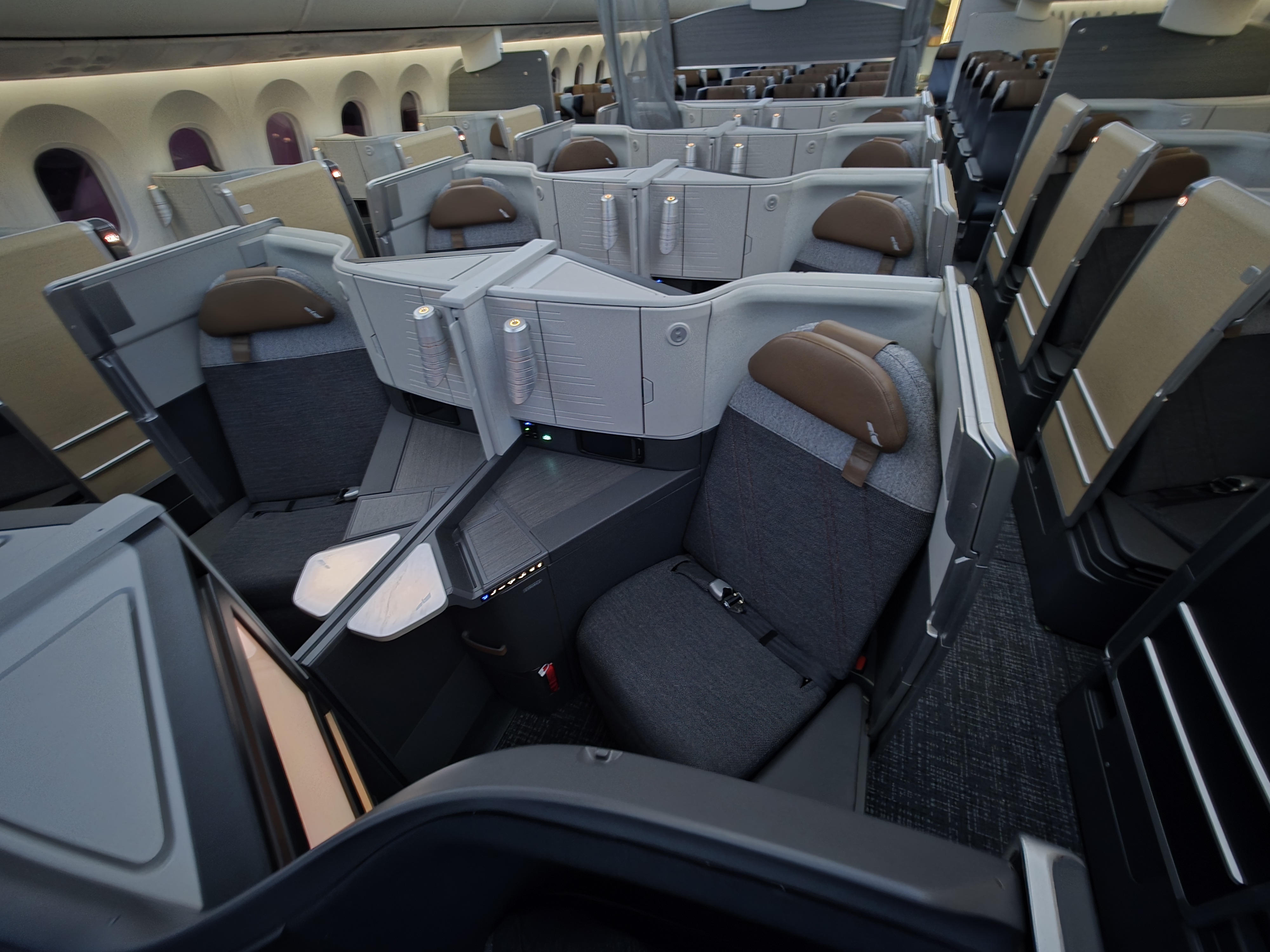
The business class suites are excellent. Premium economy is excellent, too (each seat with both foot bar and foot rest).
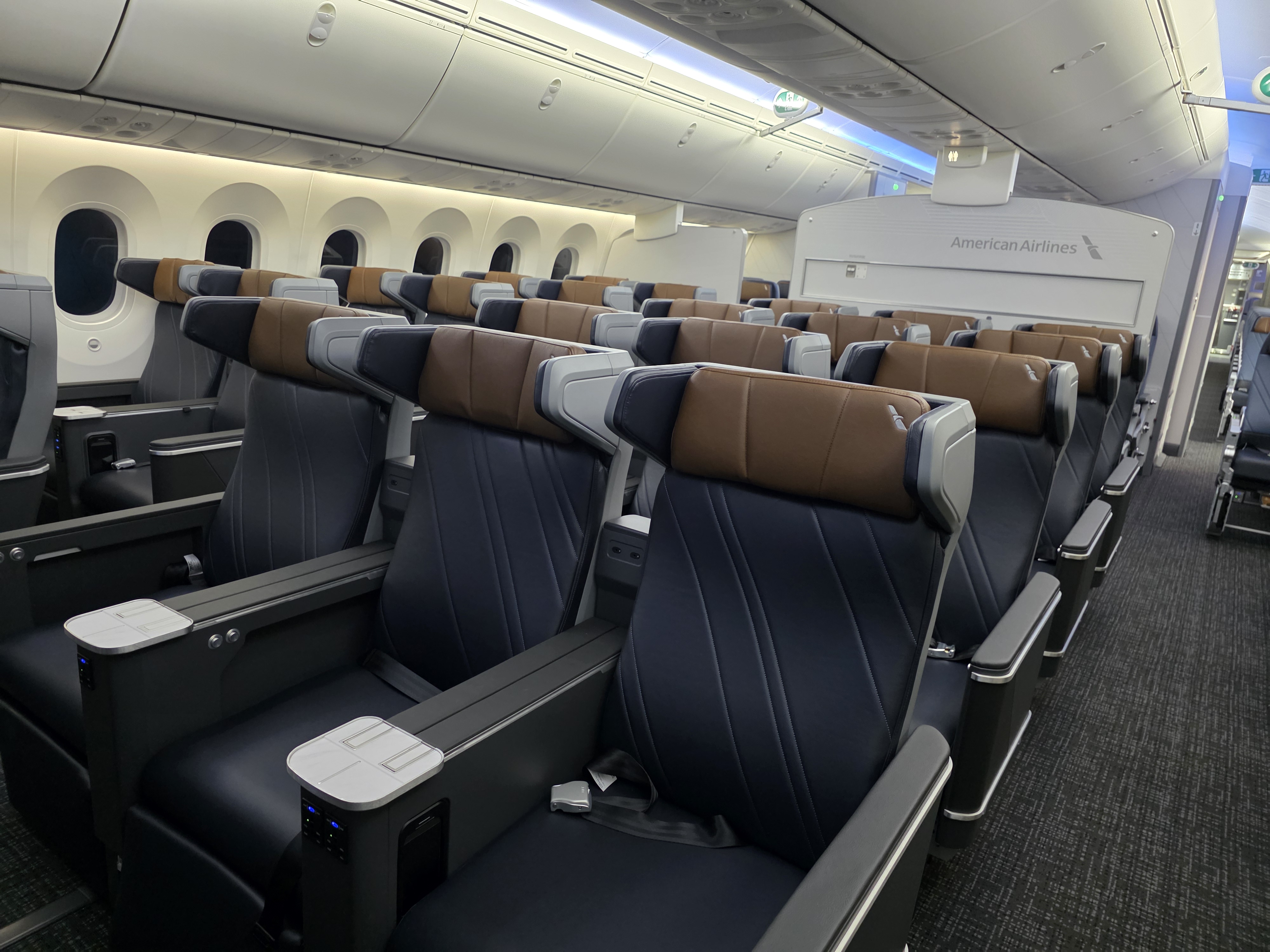
Boeing 777-300ERs will be retrofitted with a similar cabin, but there are no announced plans to upgrade the rest of the fleet. New delivery Airbus A321XLRs will get a business class suite with doors and new premium economy as well.
- Enlarged premium cabins coming to Airbus A319 and A320 aircraft, each getting an additional row of first class. And the Boeing 787-9Ps and 777-300ERs will have more premium seats than their predecessors. These additional seats are achieved, though, densifying the aircraft and taking space from lavatories and galleys.
- New lounges. American just opened its Philadelphia Flagship business class lounge. A six year delay means it’s in the airline’s new lounge aesthetic, which is a vast improvement. The new Washington National E Concourse club, Denver, Newark, and Philadelphia A-West Admirals Club feature this design. They’re going to build a new business class lounge in Miami, repurposing the current one for additional Admirals Club space. And they’ll finally start building the Austin lounge they promoted four years ago.
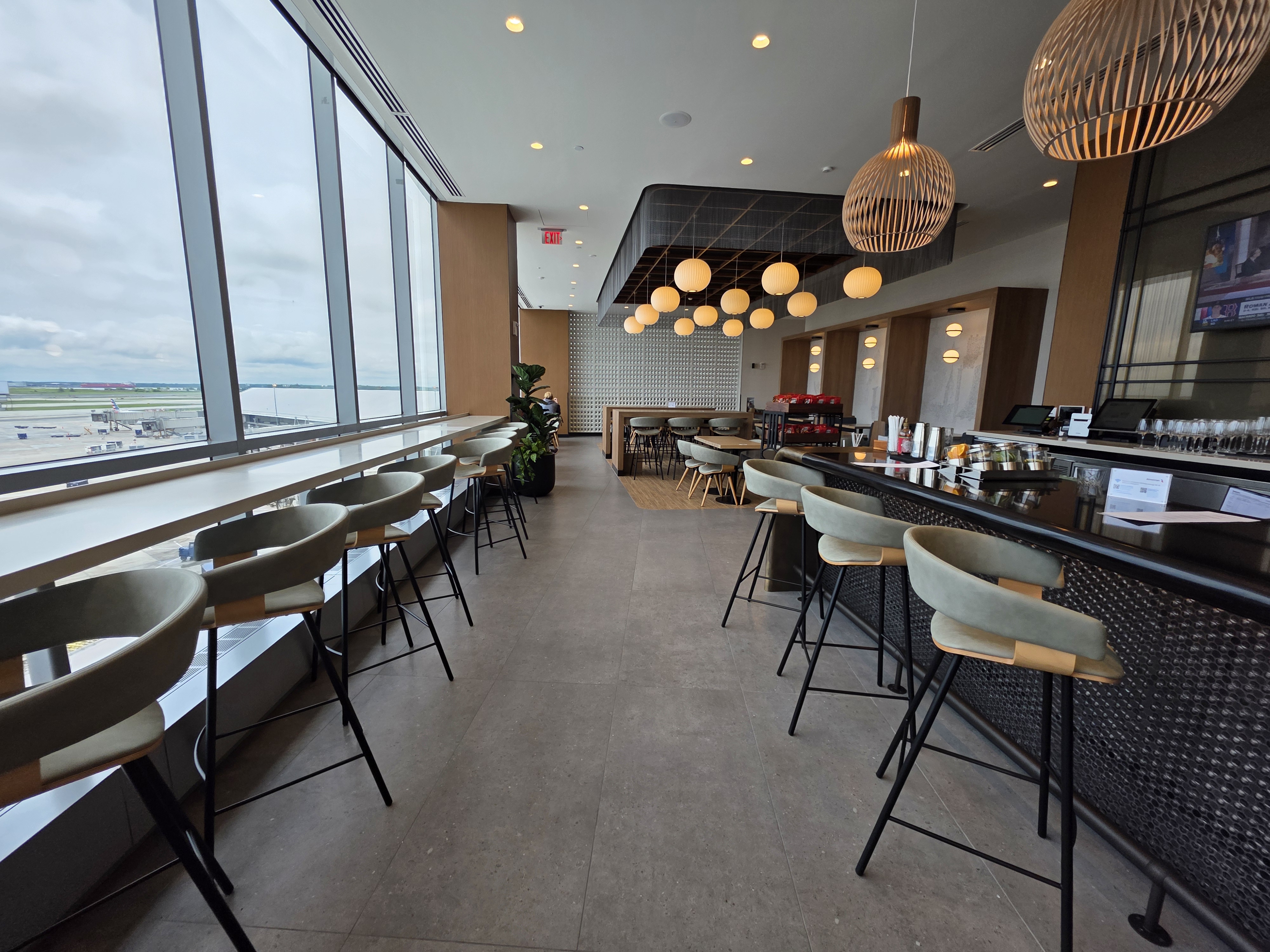
Philadelphia Flagship LoungeUnfortunately there are no announced plans to refurbish existing lounges in the new design, and while their lounge food program is more robust than it used to be it still trails Delta and United.
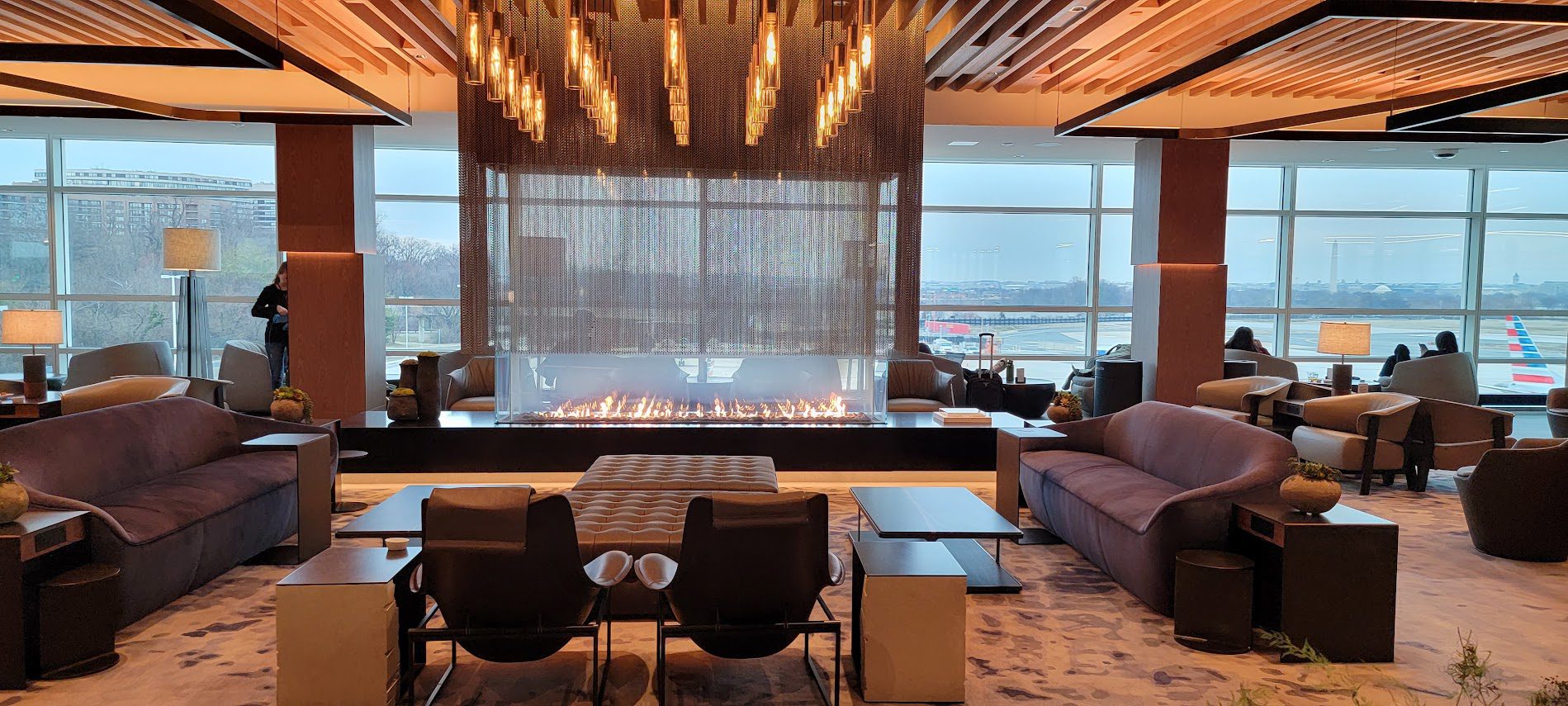
Washington National Airport E Concourse Admirals Club - Free wifi. This is coming next year to 90% of the fleet (Intelsat and ViaSat-equipped planes, but not Panasonic-equipped widebodies). Delta and JetBlue are already free, while American’s wifi is the most expensive in the industry. United is going free as they bring Starlink onboard, which is the fastest with the least latency. ConciergeKey members get free wifi now, while the rest of us wait for sponsorship revenue from AT&T to begin coming in.
- Better policies like fewer frictions in standing by for a flight, and no longer collecting headphones in business class an hour before landing (waking customers up to do it – the reason I always declined the headsets in the first place, hoping to be spared this exercise).
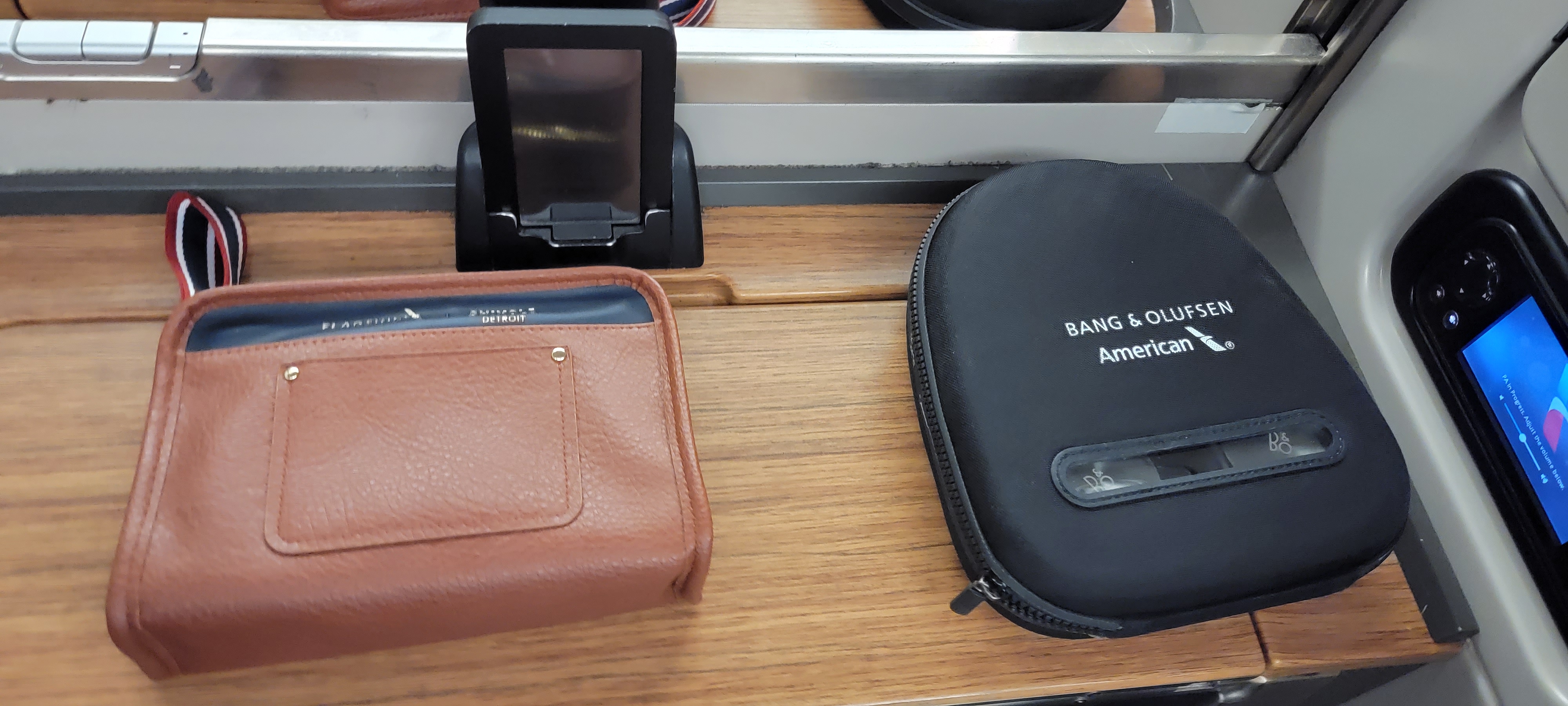
Interestingly, Garboden reports that they’ve “seen a 10% reduction in gate checked bags just within” the past couple of months, though it is not exactly clear what change exactly drove this – but if they can maintain it, it’s a big win for the customer.
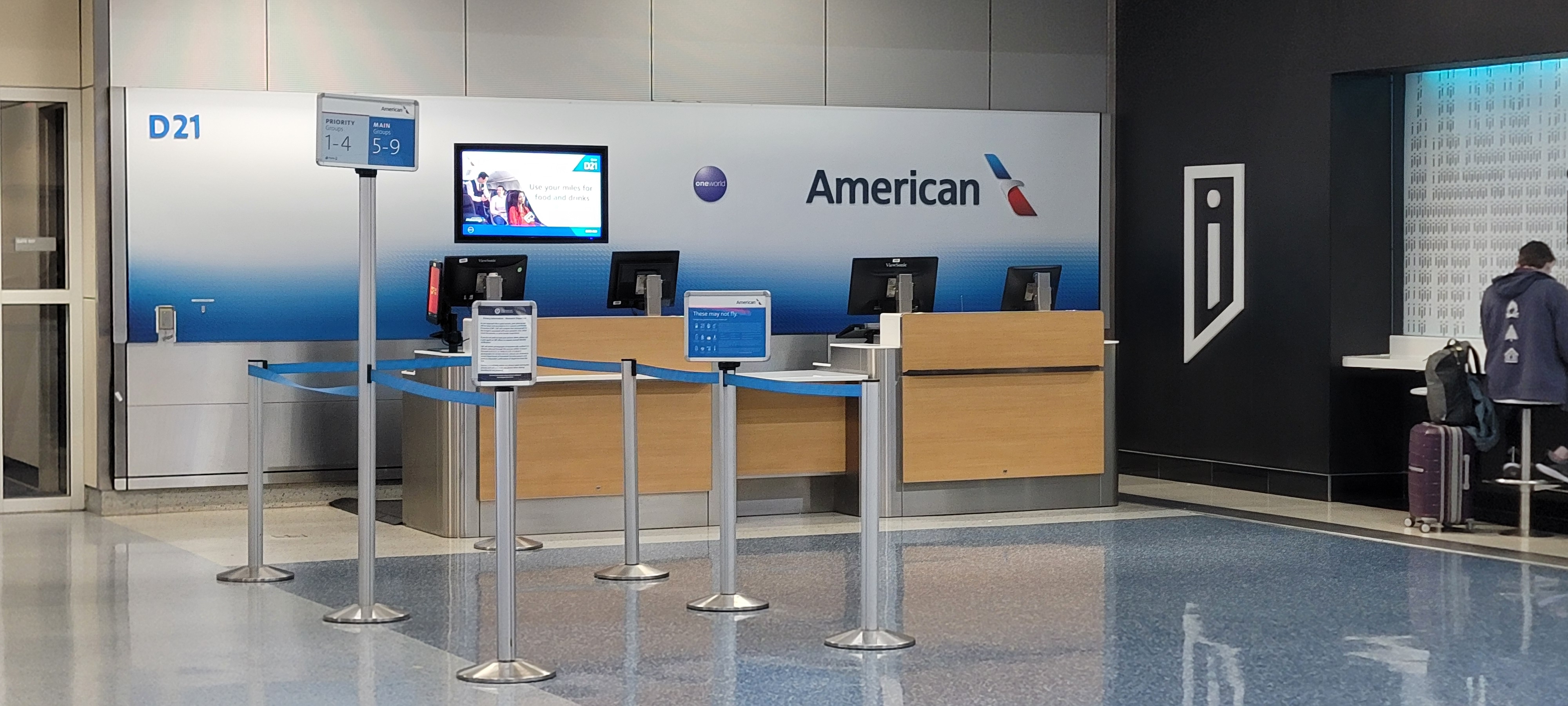
- Improved coach food for sale American has started offering more food for sale, and offering it on more flights. They don’t offer as many options or offer it on comparing flights to United or Alaska, but they’re beginning to invest here. (Alaska’s is probably best, but even United offers hot food.. that occasionally gets raves from flyers.)
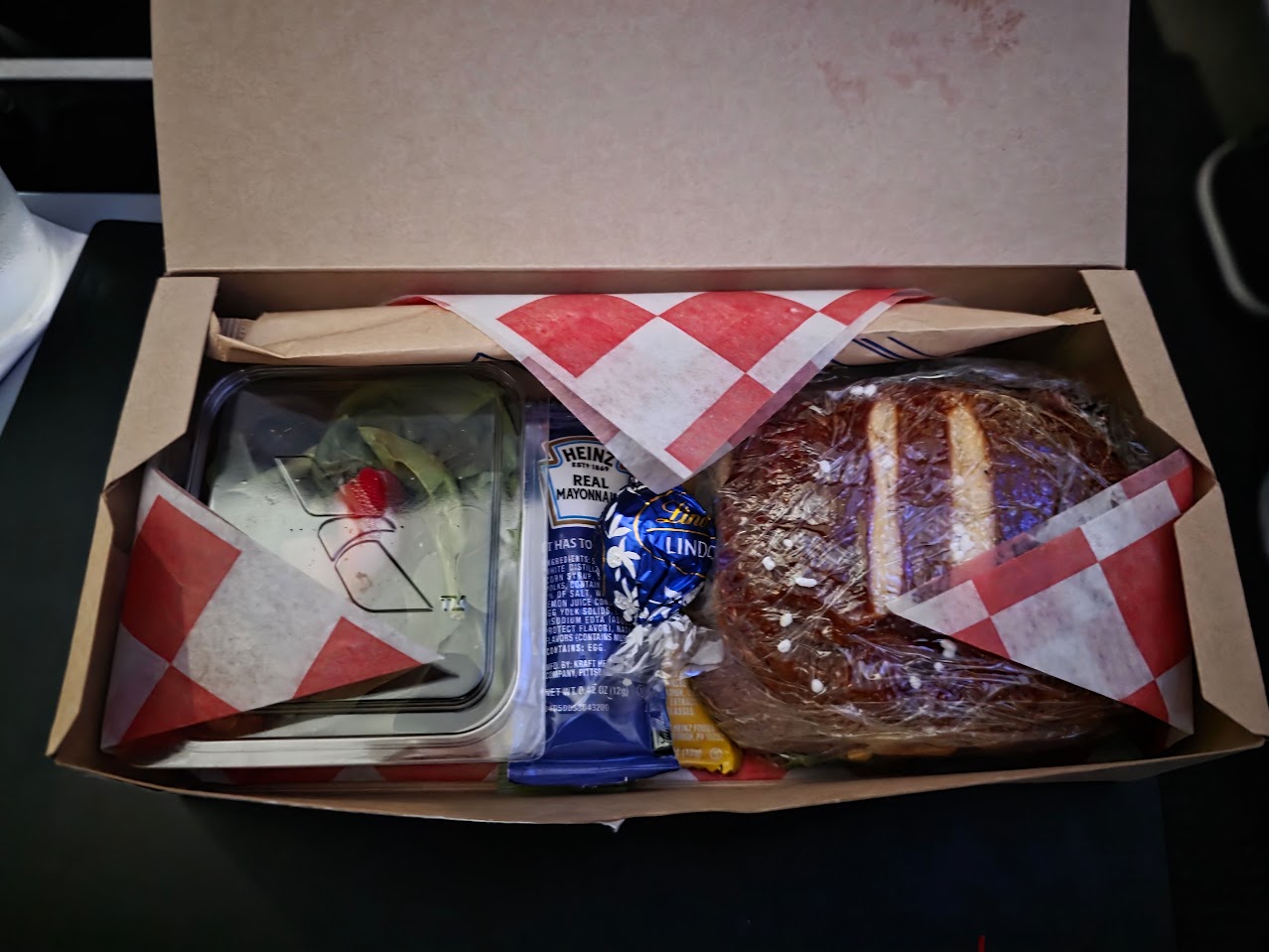
That’s important, because most passengers fly coach. Premium cabins get the bulk of the attention, but that’s not the bulk of the experience. There’s less money to invest here, but thoughtful and careful attention to the coach experience matters because it’s what most customers are buying, what most customers know, and how the airline’s reputation is formed (plus, many of today’s customers will be tomorrow’s premium customers).

There are a lot more policies to go, like the most restrictive same-day change policy among major U.S. airlines (you have to keep your original routing and only have access to very limited inventory) and most-restrictive rules for through-checking bags (you can’t even do it on separate American Airlines tickets).
And most of the improvements we’re seeing have been in the works for a long time, far predating the new Customer Experience Organization at the airline.
- New business class suites date to 2019, with the specific seat under consideration since at least the start of 2020.
- The Philadelphia Flagship lounge was slated to be finished before the pandemic.
- Free wifi was in the works in 2019 as well, with press releases literally written to match whatever Delta announced (they were expected to do free wifi then but found their planes lacked sufficient bandwidth to keep up with demand when price went to zero).
- Even not taking headphones early was a test that began in 2022.
So the real question is going to be whether they’re:
- Willing to make real new investments when those cost money, such as investing in their lounge program and retrofitting existing Boeing 787s and 777s with new business class.
- Make bets on their ability to turn a better product into more revenue, for instance by removing seats from aircraft and adding more extra legroom Main Cabin Extra product (they significantly trail Delta and United with these, and they’re often not available to buy – let alone in enough quantity for a family to buy several).
- Going to make customer experience a focus throughout the company – historically there’s been little benefit to managers to pay attention to the details because a seat was viewed as a seat, amenities were box checking, and the goal was to get each required element done at the lowest cost (so wine selection gets outsourced to the vendor, for instance, at an agreed-upon budget).
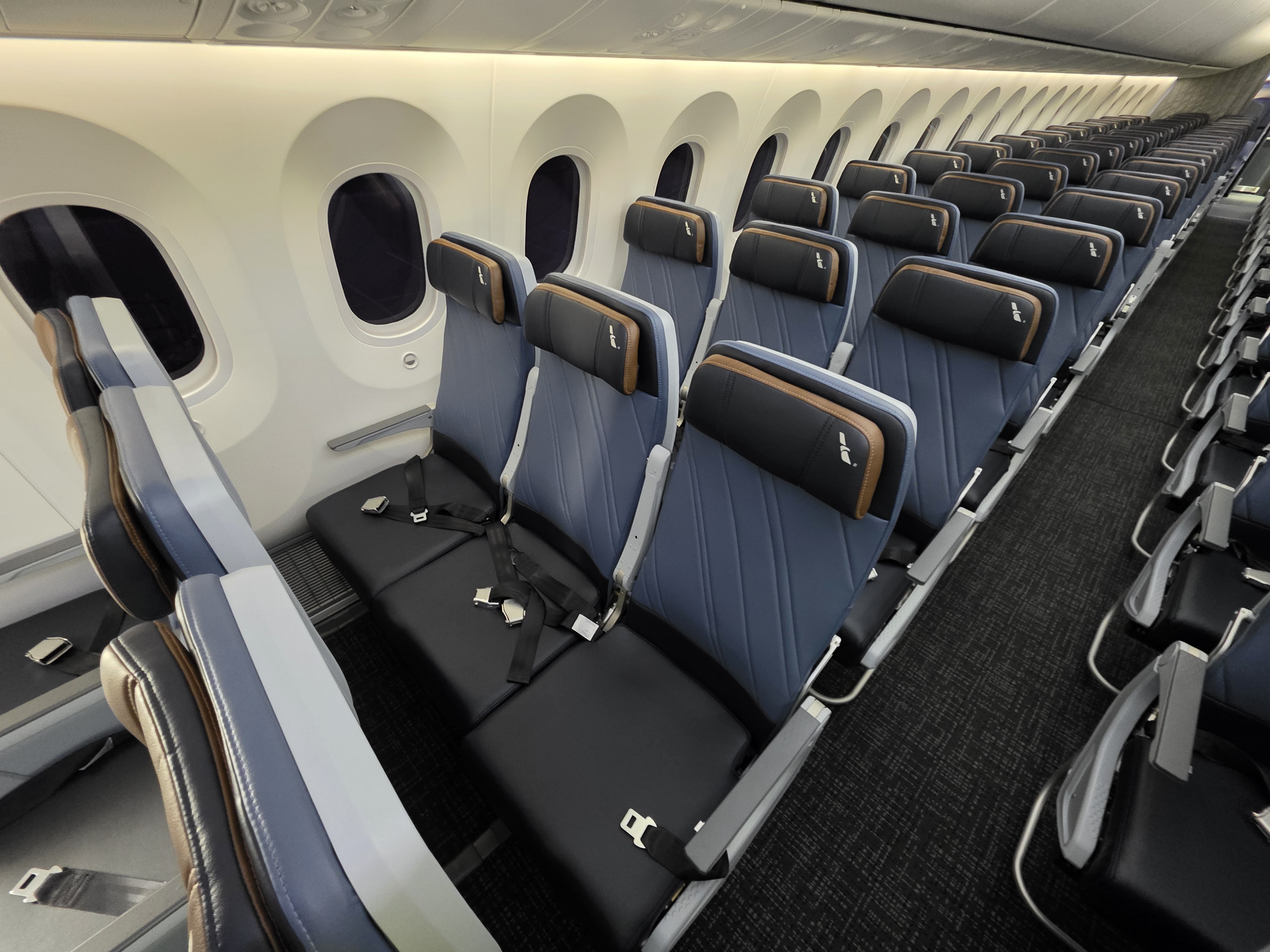
And, of course, whether the importance of how a customer experiences their travel can be translated out to the front line from check-in counter to gate agent to crew on board. While United gets too much credit for having shifted to premium, significant improvement can be traced to the time that former CEO Oscar Munoz spent visiting with employees across their system, convincing them that they had a bright future and that they needed to work together to achieve that.
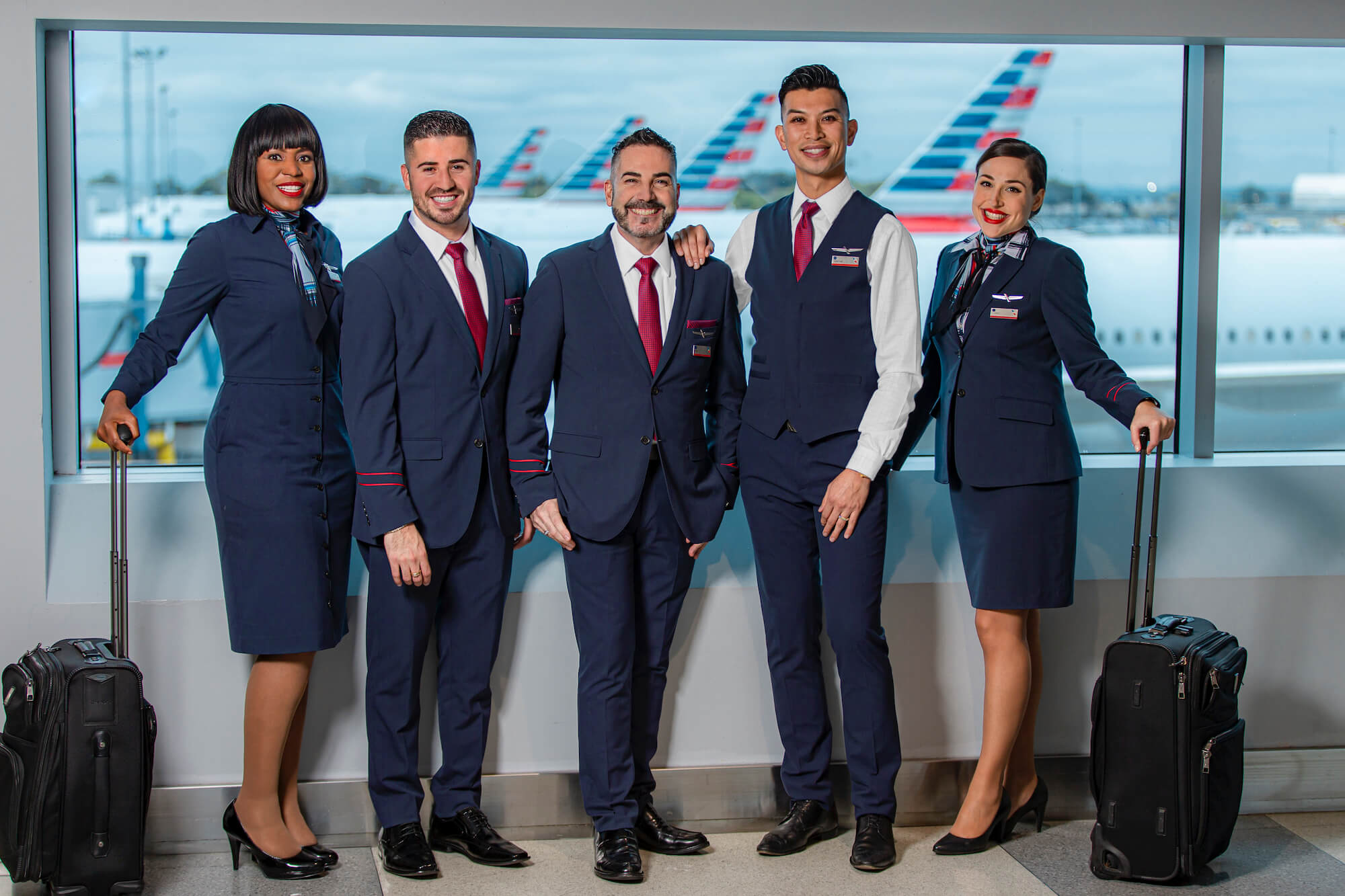
Garboden reports both to Chief Strategy Officer Steve Johnson and to Chief Operating Officer David Seymour. She needs to please both, and convince CFO Devon May to go along with investments. And we haven’t seen Robert Isom out on the front lines the way that Munoz was.
The Airlines Confidential discussion touched on American’s new Customer Experience Advisory Board, which brings in folks from Auberge Resorts, Marriott and Disney. But it doesn’t bring in customers – Garboden says that these folks are also road warriors. Disney charges a lot, nickel and dimes, and Marriott no longer stands for the consistent guest experience they did a decade ago. Maybe the right advice is flowing here, maybe it isn’t, but I doubt that’s the binding constraint.
Garboden, unfortunately, sees legroom on the plane as fixed althogh I’m not sure why that should be the case. Certainly interior retrofits across an entire fleet can be years-long affairs (“when you put together a LOPA, it takes years to do that”), but adding Main Cabin Extra and removing a row of seats (say, to match United on like-aircraft) doesn’t actually take very long.
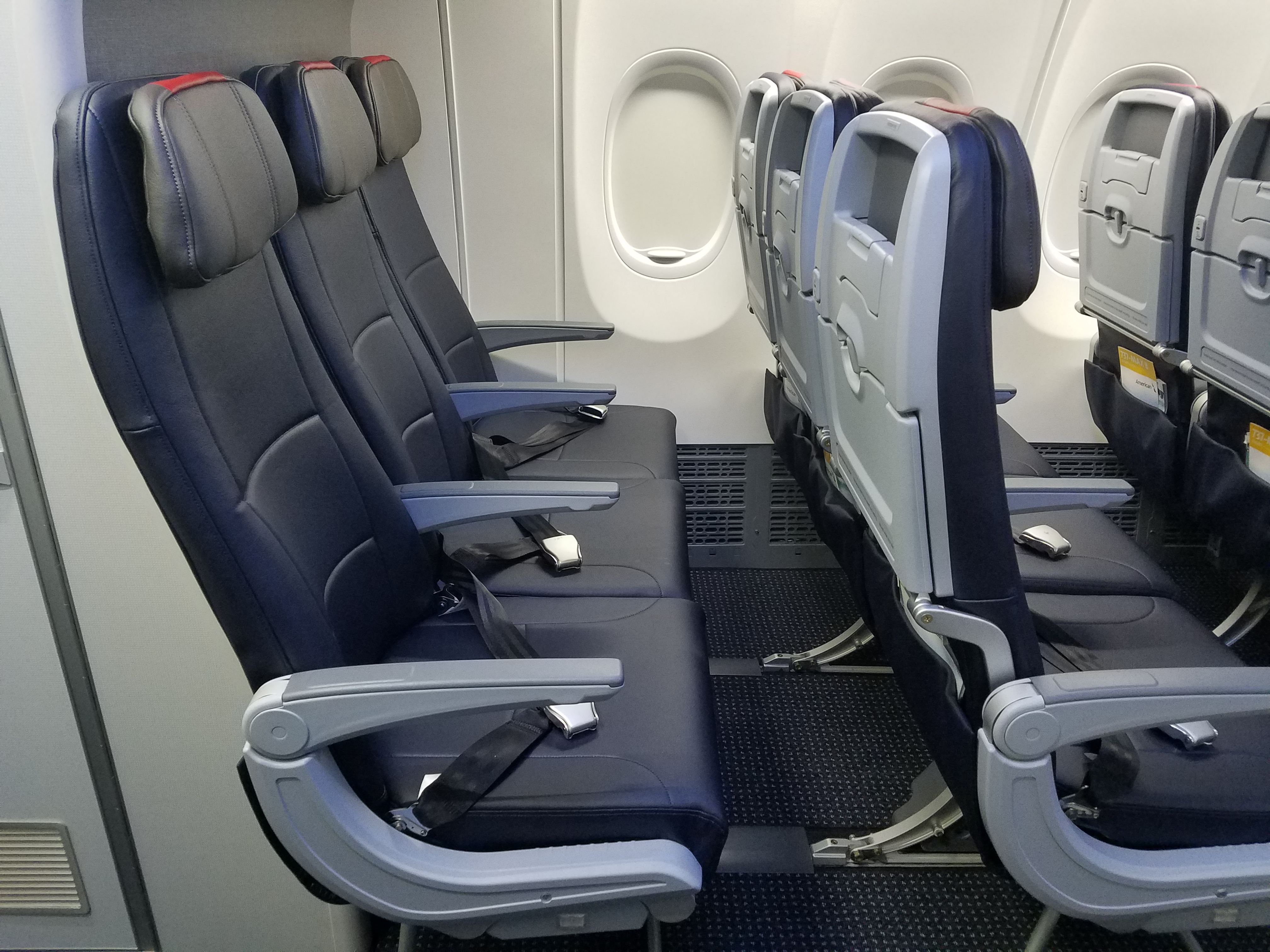
Her excuse for having insufficient extra legroom seats is that “main cabin extra was still a newer product” when they came up with the interior configuration for their 737 MAX and 737-800 aircraft (that first debuted inflight in November 2017). But United introduced Economy Plus seating in 1999, and newness isn’t why Main Cabin Extra got shrunk so much.
It’s that American’s plan for the aircraft originally had regular coach seats at 29 inches of pitch (the distance from seat back to seat back) rather than 30, there was an outcry, and they reconfigured their plan on the fly to squeeze the Main Cabin Extra section rather than remove seats in order to avoid going down to Spirit Airlines territory in the very back.
She does acknowledge that “if we looked at it today, would we think about it differently? We probably would.” If you don’t have coach seats that come at a modest buy up, customers don’t have the opportunity to buy up.
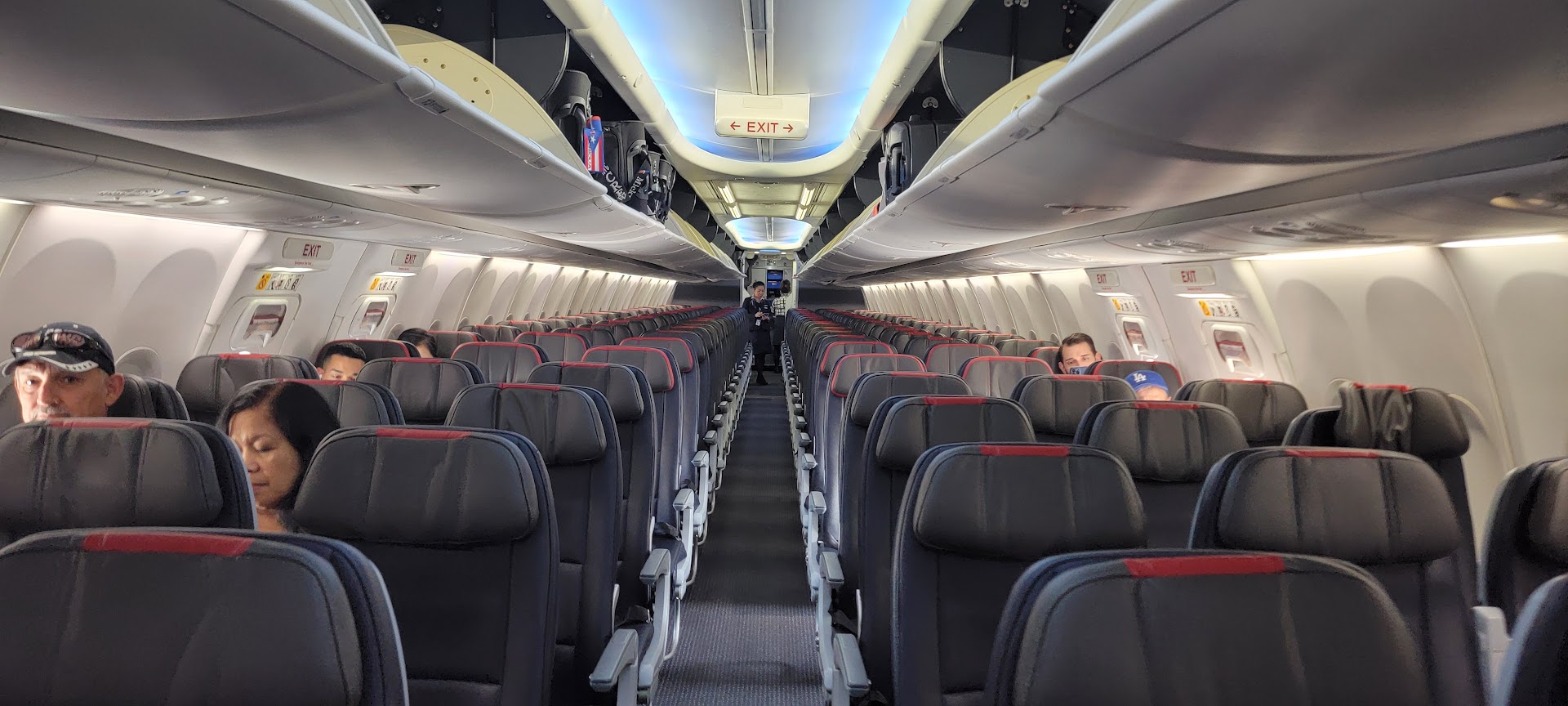
Garboden also acknowledges that they “largely defined [customer experience] as running a reliable operation” but “that’s almost table stakes at this point.” This is the exact language I’ve used nearly 80 times on this blog in the past 10 years.
At the conclusion of the interview, guest co-host Henry Harteveldt offers that she’s the right person for the job but (it’s long, but worth reproducing in full):
Heather has to help American Airlines recover from, frankly, a decade or more of neglect to its customer experience. …[T]here is so much that the airline has not invested in. And in fact, the airline has gone backwards. It’s removed in the inflight entertainment screens, for example, from the legacy American Airlines narrowbody fleet. It has that awful and ironically named Oasis. Having a configuration on the 737 fleet, there is no God in the American Airlines Oasis configuration. It’s just miserable.
And you know, American, as I said, a few weeks ago, has a very gray, murky brand image. I certainly appreciate the fact that Heather has been, I think, very frank in her assessments of what they want to do.
I like the fact that she has created a customer experience advisory board. You know, you can certainly question some of the selection of Aubuerge is a phenomenal luxury hotel brand. But it caters to a very, very narrow slice of guests at the top, literally the top 1 to 2% of travelers. Marriott certainly has a much broader portfolio of products, but also has allowed its brands and hotel owners to not enforce certain service and brand standards in order to keep them in the network. And Disney has the theme parks. But if you go to the theme parks, it’s not exactly a great experience. The rides can be fun. They’ve got great brand franchises like Star Wars and others. But they charge you through the nose for a ticket. And then they charge you for the skip the line passes and everything else. It’s almost a negative customer experience as well as a costly one. Almost like an airline.
So I’m just wondering what kind of advice will they provide? And even if they do provide the advice that American needs, will American listen? I know Heather will. And I think one of the greatest strengths in Heather’s background is the fact she does come with a revenue management and finance background. So she speaks the lingua franca, if you will, of American. That is an airline ruled by finance and ruled by revenue management. But it needs to be ruled by the customer.
And so it’s going to take a lot more than improving the mobile app, which the improvements are good, but they’re not great. American Airlines used to set a standard of excellence for not just the US airline industry, but for the global airline industry. They used to be innovative. They used to be pioneers. I’d like to see that same energy come back.
I hope Heather can help make that happen. She’s got great people working with her. I think they’re very dedicated to it. And you know, we also have to acknowledge that American is a massive complex enterprise. You don’t fix anything quickly with any airline of that size. So even if American did want to change the low bar on certain aircraft, it’s going to take time. If they want to improve lounges, which they need to, it’s going to take time. If they want to improve the onboard experience, which they need to, it’s going to take time.
Meanwhile, United and Delta are ahead of American. And that gap that they have over American, I suspect will continue to grow. The exciting thing for Heather and her colleagues, can she convince American to overtake and leapfrog, or United and Delta are and where they believe they’re going? So that American is once again, the leading premium brand. If they are, I think they have the potential to be highly successful, especially when you look at the hubs that they have, and the opportunity to leverage the fleet that they have.
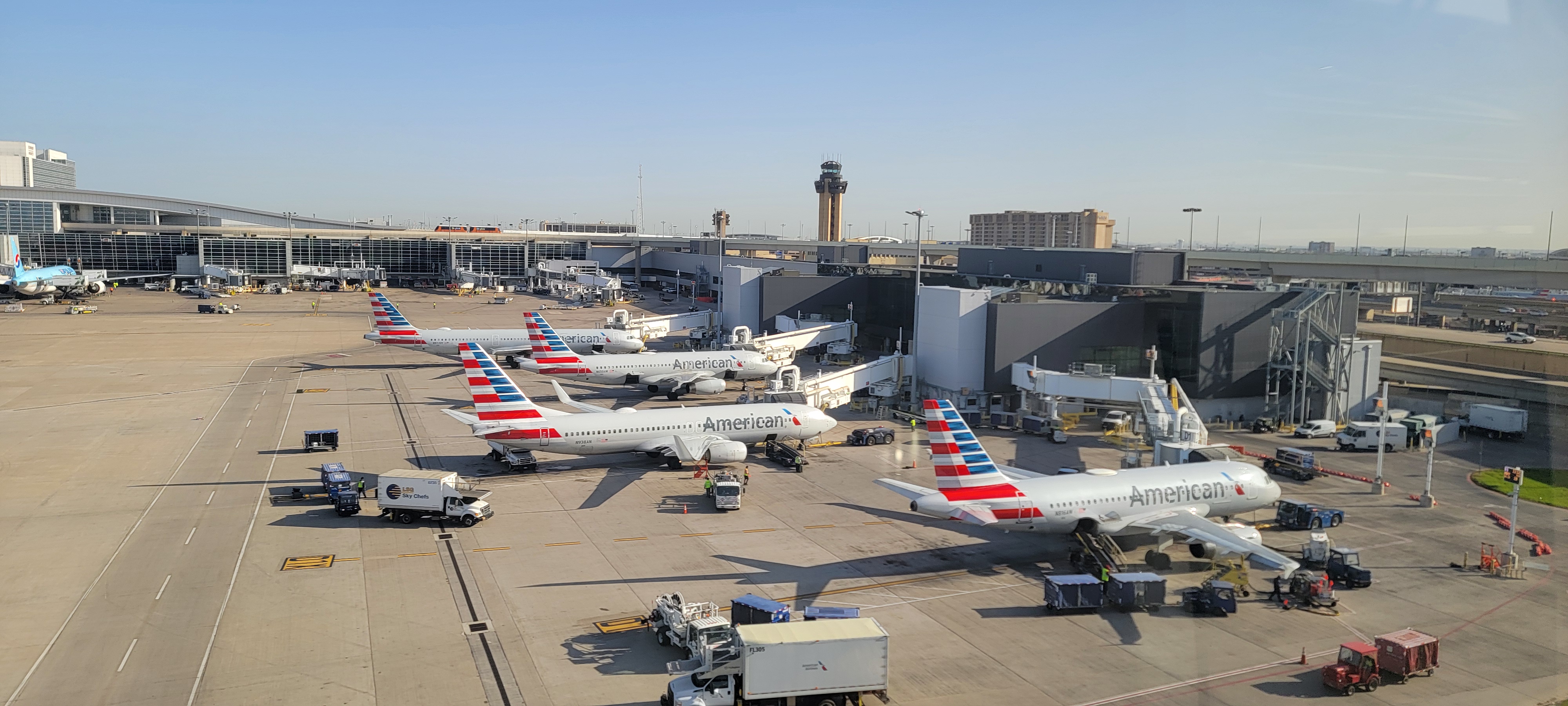
The problem is that American Airlines has high costs, but an average product. Customers choose them on schedule and price, not because they’ll go out of their way to do so – the argument Delta makes about their business.
American needs to earn a revenue premium given their business (or shed the kind of costs that can only be accomplished at the courthouse). So as a business they need to attract cusotomers and convince them to pay more because they’re better. To do that they actually have to be better!
Whether or not they can get there is an open question. I am skeptical-but I am hopeful. In the meantime there are absolutely incremental wins, and a lot of positive things about the airline for customers to look forward to.
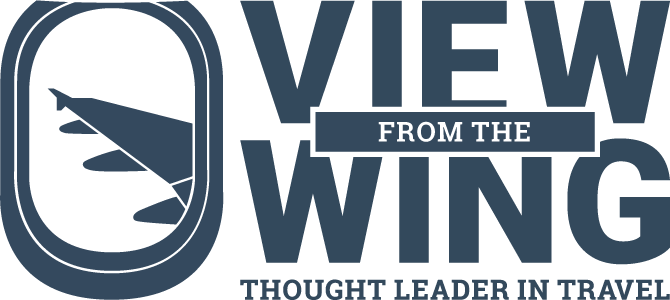

Anyone can improve the expensive seats. Let’s see what they do with steerage.
The 787-9 business class seats look OK.BUT: If the food and cabin service don’t match the seats, what’s new? Who wants to take a bet on energized and engaging staff serving better food and drinks?
I don’t think I’ll hold my breath….
Is it just me that AA’s new premium cabin already looks dated compared to the existing Delta One and newly announced United Polaris?
More than UA or DL, AA is better at gaslighting its customers when it comes to customer experiences. When they removed the seatback entertainment systems from most of their narrow-body fleets, they repeatedly stated that it was only a result of listening to customer feedback. I know not all passengers use built-in IFE, but I have never heard any customer asking airlines to remove that option.
turning on free WiFi is probably the single most important thing AA can do to improve its quality perception.
Unlike UA that will take years to install WiFi on its global fleet, AA can turn it on for domestic flights fairly quickly.
On its earnings call today, DL highlighted that it is nearing the final phase of its free global WiFi initiative which means that their lead esp. in international markets is going to be significant in WiFi coverage but domestically, the gap will close pretty soon.
and the number one thing AA can do is to provide a sense of a winning future for their employees and help them understand that customers really do make travel choices based on previous experience.
Even if they step up their game and that is big if, the customer service mentality in the front line staff just isn’t there. Isom is fundamentally an accountant and a manager. No real vision or leadership and zero ability to achieve a comparable, let alone differentiated product.
Talk is cheap.
It’s a good article and I like the optimism, but the reality is that Heather isn’t going to be able to move the ball where it needs to be until there is a wholesale overhaul of the entire Board of Directors and senior management at American. They *will* get in her way. The America West obsession with cost savings above all else is hard-wired into their brains, which will continue to inhibit innovation — and the endless pattern of “one step forward, two steps back” will spiral (just as it has since 2013) until shareholders finally revolt or we see the next bankruptcy.
I’m an Executive Platinum member and I can’t find a couple of business class saver seats to Europe for my wife and I next May. Ditto for using my SWU’s. That doesn’t make me feel like my business and loyalty is valued in any way.
@Tim Dunn — So say we all! AA should either do free WiFi (like Delta for SkyMiles members) or install IFE screens, but to do neither is an insult to most passengers.
Sooooo…about all the surly AA flight attendants and CSAs…will they be addressed, or will the toxic attitudes and lack of service continue?
In my attempt to stoke the flames here, has our Dear Leader considered further consolidating power, nationalizing airlines? Please ‘educate’ us on how He is ‘right about everything’ (or did the Epstein cover-up finally turn you guys off)… @Mike P, @Andy S, @Mantis, @Michael Mainello, where’d you guys go?
@ Tim
+1
Well said.
She came up the ranks at Doug Parker’s America West. That’s a plus?
I agree Steve. Surly is a perfect description of American’s staff.
Of course, free wifi is the key competitive differentiator in the airline business. Who knew?
Delta started adding Delta One Suites to their international wide body aircraft in 2017 and they will have them installed on only 80 aircraft by the end of the year? That’s only 10/year and well less than half of their 176 wide body aircraft fleet? And Delta has A321 Neos parked with the engines removed because they failed to get approvals prior to delivery? How out of date is the rest of the so-called premium seating on Delta wide bodies, but hey, the wifi is free.
United’s Polaris Suites have been installed on their entire international wide body fleet of 204 aircraft for years along with new Premium Plus, Economy Plus and Economy seats and with far more premium seats (High J), but unless you have T-Mobile or high status you have to pay for wifi that is installed throughout the fleet. The new Polaris Suites and Studios in new 787s start arriving this year. United will probably have 25 of these newly configured 787-9s with this by the time the first new Delta One Suites (no studios) arrive in 2027? Yikes!
UA: 227 WB, 188 WB/501 NB on order, 15.6 average fleet age
DA: 176 WB, 29 WB/246 NB on order, 14.9 average fleet age
AA: 130 WB, 26 WB/284 NB on order, 14.1 average fleet age
Woah, what has the world come to, @MaxPower agreeing with @Tim Dunn; I guess the enemy of your enemy is your friend. Delta-fans and United-fans join in hating on American. Bah!
@1990
AIR MAMDANI. Free travel. All first class. Unlimited drinks. Just tax all the billionaires, preferably the white ones, before they split for Florida.
@Coffee Please — Thank you. Ah, “luxury” communism. If only we could harness advanced technology and ‘automation’ to create a post-scarcity, post-capitalist society… or, we can just fight among ourselves, while the billionaires billionaire.
The most appropriate saying ever is so very appropriate for AA. Money talks, bullshit walks. And that includes their latest pronouncements
At the end of the day, unless Isom and gang change the “not spend a dollar more than we have to” mentality, any true changes are a pipe dream.
thanks, Max. 🙂
JL,
you STILL can’t grasp that Polaris was an obsolete product the minute it was rolled out – which was about the same time as the Delta One Suites.
tell us how long it took to install Polaris and also tell us when the Next conversions started.
Delta has 80 aircraft with Delta One Suites – and United has zero.
notable to this article, AA has more widebodies w/ suites than UA does right now and AA has committed to refurbing existing aircraft while UA has not announced a single aircraft mod.
And United made all kinds of noise about its WiFi but will instantly fall to a distant #3 among the big 3 when AA turns on free domestic WiFi
Step back from the ledge and grasp that the game is about who delivers and not what is promised.
AA put the backbone in place to offer high speed WiFi and didn’t have the nerve to pull the trigger but will instantly leapfrog UA.
and you do realize that Starlink is not expected to gain certification on the 787 for another year?
Delta will complete its free high speed WiFi on its A350 fleet in months and get the 717 fleet done likely by the end of the year.
spare us your bragging. DL had the foresight to come up w/ strategies that UA is copying. AA has the platform to accomplish many of the same goals UA has set but far faster.
@1990
this may be a surprise, but you don’t have to reply to everyone.
@MaxPower — Thanks. *wink*
Polaris Suites and more of them (high J) more accurately reflect what the market is demanding as evidenced by United’s amazing post-Covid financial and commercial performance catching Delta. The US market isn’t going to pay for Emirates apartments and showers. Polaris the “Suite Spot” and for the few customers who are willing to pay up, the eight Polaris studios are perfect. And free Starlink Wi-Fi is coming on the new 787-9s.
I honestly didn’t realize how far Delta is behind on their premium international product installation (<50%). Some of the SeatGuru photos of the other 50+% old ‘premium’ seats are embarrassing. It is actually a credit to Delta staff that their customer satisfaction numbers are so strong. Unfortunately, I hear there is growing discontent in the ranks especially with the pilots regarding contract compliance issues.
Interesting times.
@JL — This will disappoint @MaxPower, who seems to want me to self-censor, sorry, not sorry, anyway, there’s still an upside for Platinums and Diamonds with Delta to use RUCs and GUCs from Main to DeltaOne (no middle step to Premium Economy recliners) on those ancient 763s with 2-class and the older lie-flat. So, anecdotally, as much as I certainly prefer the newer Suites on the 339, 359, and 764, especially with doors, there’s still something special with the older configurations. Kinda like how in Economy, the 767s and a330s have 2-3-2, which is nice for couples, but a 3-3-3 on the 359, which is not as nice if want to avoid middle seats. As I’ve reminisced before on here, the ‘worst’ configuration really was the old DC-10/MD-11, 2-5-2, double middle. Oof.
She is nothing but a new load of hot air. The intro says it all: An America West veteran, she came up through the ranks of Doug Parker’s airline and has a background in finance and revenue management.” With those credentials, more of the ruinous management that Parker brough as he decimated a once great airline. Very insightful note on the new “Advisory Group” coming from companies who, like AA, have shown how clueless they are when satisfying the customers. Now more than ever they need what ex-CEO Tom Horton espoused: “a through run through the car wash.” This will only happen with a total house cleaning of the C-Suite.
JL,
let’s see how UA’s international AND domestic numbers look but, as much as you want to keep touting Polaris, it is a high density product and that was known 10 years ago.
The fact that they took 8 years to install it on their longhaul widebody fleet doesn’t make it any more industry-leading.
and DL is retiring its 767s and replacing them w/ new modern widebodies, something UA will not do because they are so afraid of losing market share.
United’s 767s are not any more efficient than DL’s which just means that DL’s lead in international profits will continue to grow. The mere fact that DL’s TPAC system is almost entirely operated on A350s while UA uses a combination of 777s and much smaller B787s leaves enormous opportunity for DL to grow.
I said all along that if UA can make money on international, DL can do even more so and make more money with better products and larger, more efficient aircraft.
1990 says: So, anecdotally, as much as I certainly prefer the newer Suites on the 339, 359, and 764, especially with doors, there’s still something special with the older configurations. Kinda like how in Economy, the 767s and a330s have 2-3-2, which is nice for couples, but a 3-3-3 on the 359, which is not as nice if want to avoid middle seats. As I’ve reminisced before on here, the ‘worst’ configuration really was the old DC-10/MD-11, 2-5-2, double middle.
That’s great. I have been told that the marketing folks refer to that as being ‘bonded to a brand’. Delta has led the industry in the US for a long time and have earned your loyalty. You also seem to prefer flying out of JFK. WIN-WIN-WIN.
I made the mistake of actually believing much of TD’s obvious BS only to find Delta is actually quite poor with regards to managing aircraft interior modifications in a timely manner. It makes their soft side that much more impressive.
Tim Dunn says: DL is retiring its 767s and replacing them w/ new modern widebodies, something UA will not do because they are so afraid of losing market share.
UA’s high-J 767s are money-printing machines. UA management loves them despite this issues that older planes present. From a passenger’s perspective they have beautiful and consistent premium interiors.And UA isn’t worried about losing market share. They actually are worried about missing out on the currently unquenchable TATL demand.
The problem for both airlines is the lead time for aircraft. It is now over six years from both Airbus and Boeing wide bodies. Fortunately, for United they got in line in a BIG way a long time ago. That is an enormous advantage for United.
no, UA’s 767s are not money printing machines in any form.
They are the highest CASM widebodies in the US fleet. Other airlines offer plenty of premium cabin capacity on larger aircraft that burn less fuel per seat and also have space to carry more economy passengers and cargo.
and, no, UA has no advantage in widebody DELIVERIES – which is all that matters.
DL received more new widebody DELIVERIES than UA in 2024 and will do so again in 2025. DL has date-protected options they can exercise for widebodies so the notion that placing massive widebody orders years in advance is an advantage is pure fiction.
All UA’s massive order means is that they won’t be announcing new widebody orders for years – unless they convert some of those 787 orders to 777Xs – or decide to finally take delivery of the A350 which is by far the most capable and efficient widebody in service with any airline.
and, despite your need to brag about UA, AA is expected to receive more new 787s than UA this year. THAT reality is bound to sting no matter how badly you try to throw dirt back
@JL — For NYC international flights, yeah, I do prefer JFK, though I’ve taken EWR as well, ample times. As you probably already know, other than Canada, LGA is mostly domestic.
As for marketing, you can believe and/or promote whatever you want, doesn’t mean everyone will agree or experience it the same way.
Like many of us here, I’ve gone through phases of loyalty with the various companies. It often varies greatly based on where you are located. Like when I was in MIA, it was American. But for NYC, there’s actual competition, so we’re pretty well-balanced between the big three, though Delta and United really shine.
That said, I still think Delta treats its Diamonds better than AA its EPs or UA its 1K. I’ve been all three over the years, and with variants of status on other airlines, Mosaic, FlyingBlue, etc., and still, I prefer Delta’s treatment of its elite flyers over all.
Would you or @MaxPower like to passive aggressively request that I stop talking, again? That’s a good one.
and this is a good time – since we are talking about NYC – that DL’s operation in NYC was CONSIDERABLY larger than UA’s at EWR plus its tiny operation at LGA – and UA is looking at that to remain the case for months if not years to come.
The fact that NYC is experiencing near constant afternoon ATC delays does not bode well for adding back any capacity to the NYC aviation system. Since LGA and JFK are both slot controlled, the only change regarding adding back capacity has to be at EWR and that appears to be nowhere on the horizon, if ever
UA dramatically gave up domestic size in NYC as the FAA cut EWR capacity. If anyone believes in S curves, it should be obvious that DL’s much larger domestic size will translate into a stronger position in the international market.
Tim Dunn says: UA’s 767s are not money printing machines in any form.
Actually, they are. The demand over the Atlantic is insatiable and UA has far more international wide bodies and far more premium seats per plane than the competent..
and, no, UA has no advantage in widebody DELIVERIES – which is all that matters.
Poor little fella.
UA: 227 wide bodies, 188 wide bodies on order, 15.6 average fleet age
DA: 176 wide bodies, 29 wide bodies on order, 14.9 average fleet age
AA: 130 wide bodies, 26 wide bodies on order, 14.1 average fleet age
1990 says, Would you or @MaxPower like to passive aggressively request that I stop talking, again? That’s a good one.
No I get the affection between TD and you. You all have a lot in common.;)
American is a mess. Ranks at or near the bottom in on time performance. Too large an airline to make changes in what is the industry’s 7th inning before a plummeting dollar, stupid US foreign and economic policy tank the economy. American is at this point, a decade behind DL and UA. Best it can do is file Chapter 11 again, restructure its debt, and find itself a merger partner.
The strategy technically and structurally is good to turn around the company however, you can have a superior product whether it be the structure of the product or technology, but if you have low morale and senior management does not treat their employees with respect and listen to their front line employees Such as Mr. Crandle did during the peak Zenith times with American back in the 80s and 90s you’re not gonna be successful. There needs to be a channel of communication between Frontline employees and senior management. The present senior management at the moment is treating a global airline like a regional carrier. They’re not going to be successful. They lost New York they lost the Tracon market And now they’re almost irreverent to the market itself the commercial airline market so while the product is good. They have the best fleet they have the best alliance. They have the best train pilots flight attendant. The culture has to be stimulated and reinvented as to the way it was when Mr. Crandall was CEO if you take care of your employees, they will take care of their customers and that’s a philosophy that we had in which Delta and United hijacked that’s why they’re successful today and this is coming from an individual who worked with American 40 years retired 10 and knew what excellence was during my particular rain and employee at American Airlines during the 70s 80s 90s and early 2000s I wish them well. American was not just a company I work for but it made me into the individual that I am today it’s culture. My friends are still with summer with American summer retired but even the travel agencies I worked with are still friends we were family. We weren’t just a number that has changed in the past 1015 years. I hope they regain the pride and the amazing commercial Airline culture of the company
@JL — Aww, thanks buddy. You’re always welcome to reply on here. Why not!
JL
This article is about American and not your need to boost your self-esteem by making false claims
Orders don’t matter. Deliveries do. Delta is receiving more widebody deliveries than any other US airline. American will receive more new 787s this year than United.
Delta flies more wide body capacity to Europe than united does. United’s slightly larger size to Europe is because of their inferior narrow body aircraft. They are larger size across the Atlantic is because of their larger presence in the Middle East and India.
And yet, Delta still earns more profit across the Atlantic than United does by a wide margin. And if you or anybody wants to disagree with those statistics, then tell us where United’s higher profits should come from because it certainly isn’t their domestic system.
The commentators talking about bad customer service (e.g., @Johhny) are spot on. @TimDunn – wifi is number two in my opinion, not number one.
Yesterday’s (7/8 to 7/9) experience with American was a case in point. I had brought my 19-year old grandson from COS to DTW for a week with us on Lake Erie. Alex had not flown since his father did a rotation to Korea when Alex was 11, and had never flown alone.
The outbound COS-ORD-DTW on UA was uneventful. He liked the people on UA, and, at my urging, had a Chicago Dog at America’s Dog at ORD. So far, no problem.
The return flight DTW-DFW-COS on AA was a disaster. The gate crew at DTW (AA 3130) forced him to gate check his carryon, despite there being plenty of bin space (he boarded in Group 5, as I won’t buy basic economy for my grandchildren). When he got to DFW, storms rolled in. His 2110 flight to COS (AA1857) was eventually cancelled, and he was rebooked (by me) on the 2250 flight (AA 790). Despite the decreasing storms at 0100 the next morning, and despite the fact that the inbound aircraft was still enroute from SDF to DFW, his flight was cancelled. I suspect that the crew from the inbound would have timed out, although AA claims it was solely due to weather.
Rebook proved impossible by any means. Using the app offered only flights on Friday, two days later, with no meal or hotel assistance in the 2-1/2 day interim. Phone connection times were in excess of 4 hours waiting. Chat would continuously disconnect. And finally, connecting to @American through X yielded only two possible flights: to EGE or ASE with no assistance for the $500+ cost to get him to COS. When those were declined as not useful, I was then ghosted by @American on X.
I finally put him on DL at 0700 DFW-ATL-DEN, with a Groome shuttle ride to COS. Thankfully, he made it home in time for his father’s birthday celebration that night. And his experience with DL was excellent.
When I inquired about ticket refund, I was told that AA would refund only the unused portion of the ticket — DFW-COS.
Yes, Amex Plat is already working on a trip interruption claim. But I have three observations from this experience:
1) An airline is only as good as their irrops customer service. AA was an EPIC FAIL. Alex slept in DFW for about 4 hours until his DL flight (not enough time for him to get any rest if I had put him in the Hyatt at DFW. No assistance of any kind was offered by AA – whether meal voucher or otherwise. And there was clearly staffing issues in AA customer service regardless of the medium for contact. AA Management clearly does not value customer service and refuses to put dollars into what is a cost center (i.e., “Don’t spend $1 that is unnecessary.”). If they truly valued customers, management would make the repurchase survey at the end of a phone call — “On a score from 1 to 5 — Would you recommend AA as a result of your experience?” — a significant component of executive bonus compensation at every bonused level of management.
2) I find AA’s offer to refund only the unused portion of Alex’s ticket hypocritical in the extreme. AA, like other airlines, takes a very hard line on “skiplagging”. They maintain that tickets are priced and sold on the basis of origin/destination, without regard to any connection. Therefore, not using the second (or subsequent) connection on a ticket theoretically subjects the offender to charges and possibly losing mileage, or even being banned from the airline. Yet, AA ignores this same principle by refunding only the “unused” portion of the ticket, regardless of the fact that the ticket was priced on the basis of the entire journey, and the stopover was not part of the journey. The fact that AA could not transport Alex to his ticketed destination in a reasonable time period –within 72 hours, and would not consider alternative airlines — apparently is of no consequence.
3) Once, I had a client named Lee Iacocca (and yes, he knew me and I knew him personally.) Lee observed that a company always should have a bean-counter as the #2 person, and a sales guy as the #1 (like Lee). This would keep the company from spending too much to generate sales. But Lee also observed that having a bean-counter as #1 was a sure-fire way to save the company into oblivion.
One additional observation — in the past two years, my partner and I have flown about 8 flights on AA. Only one (about 12%) landed within 45 minutes of schedule. So much for Isom’s vaunted “D0”, and “reliability being table stakes”.
Tim Dunn says:
Delta still earns more profit across the Atlantic than United does by a wide margin. W
Really? Please show us the profit numbers for both airlines over the Atlantic. This will be interesting.
JL,
see the DOT”s profitability by global region data which is publicly available.
In 2024, DL’s international system generated $1.4 billion in profits compared to $2.3 billion for domestic. DL’s TATL system was $1.1 billion.
UA’s int’l system generated $1.3 billion in profits compared to $1.8 billion on domestic. UA’s TATL system profit was $830 million.
and since this article is about AA, their TATL system lost $485 million for 2024 and TPAC lost $261 million. Their Latin system made $640 million and their domestic “only” $1.37 billion
whether you or anyone else want to argue w/ the numbers, DL runs its network for profitability and it shows.
I have not flown on American Airlines for decades and am even less inclined to fly on them in the future due to reports about how they operate. That being said, routing flights through DFW or ATL in the summer seems to be a disaster waiting to happen. There are usually good northern city routes that are less likely to have weather issues in the early summer. The best customer service is the one you don’t have to contact because everything went as planned.
@jns — You’d think that (northern cities), but sheesh we’ve had a lot of delays in the NYC-area this summer. Flying AA tomorrow and already expecting 1-2 hours late. We’ll see!
What this means is that AA’s best customers are going to be taken care of. Most people in the back, well…. I must say I was impressed. At SYD there was a premium services rep that met me and another CK upon deplanning, took us to the very front of the Customs Line (even bypassing crew), said two VIPs and we were through Customs in a matter of 5 minutes.
Hope I get that coming back through LAX.
TD and JL, take it outside.
Who ever commented to 1990 about his constant replies I am 100% with you. Along those lines, 1990s obsession with Mike Hunt and his nose so far up TDs ass make it seriously difficult to take anything they have to say with any credibility.
@TD I agree that once AA makes wifi free they will leapfrog UA. the bones are there, for quite awhile.
Heather has been given the free rein to make AA competitive. Isom needs to stand aside and let her do her job.
@Pilot93434 — Clearly, y’all see my stuff, otherwise you’d just ignore it. Noted. I’ll keep up the ‘good work.’
” There are usually good northern city routes that are less likely to have weather issues in the early summer.”
“You’d think that (northern cities), but sheesh we’ve had a lot of delays in the NYC-area this summer.”
You pay your money and take your chances. If I was trying to fly DTW-COS, I would fly Delta through MSP or through SLC. I think that DTW-DEN nonstop and then the shuttle would actually be a better solution for an experienced traveler. I really like nonstop flights.
On April 30 I flew from LAX to BUF on JetBlue with points. I flew before the LAX to BUF nonstop had started for the year. I had to use a connecting airport. I could have flown through Boston but I chose JFK because I had a longer connection and also because there were more options from JFK to BUF if needed. The weather at JFK was fine. The whole trip went off like clockwork.
pilot,
I take the shots when they need to be taken.
JL brought UA’s fleet and his obsession with their international network into this discussion.
This discussion is about AA and AA is moving more aggressively and decisively to deliver the strategies that UA has been talking about for years.
AA announced its new generation suite and started plans for installing it before UA announced their plans; AA is further along and will have more aircraft w/ the new suite – which happens to be the same product UA will have.
AA has the structure in place to offer WiFi for free long across far more of its fleet before UA does.
AA waited far too long to recognize what it needs to do but it is doing it now w/ resolve and determination.
I AM OPTIMISTIC that AA will turn the ship around.
They have a lot to do but they have the potential to do far more than UA can; AA at least has bothered to settle w/ ALL of its labor groups instead of touting its profits while SIX, yes, SIX labor groups have amendable contracts.
@jns — This is why I always keep some spare points around in case I need a ‘backup’ plan with a different carrier. Unlike with paid tickets, points are usually an easy cancellation (before departure) and a quick no-fee reissue with most US carriers. The reliability issues have been a bit of a ‘thing’ since Crowdstrike last summer. It can happen with any of them (or all of them, if weather at a particular airport/region). Though, when I was in FL, it was wild when MIA would be ‘out’ but FLL or PBI would be fine. Traffic getting between never fun, but still, if it’s the difference between ‘making it’ to where you need to be, or getting stuck, you do what you can.
@Tim Dunn — Keep taking as many shots as you can. If that was a basketball metaphor, I say, ‘nothing but net!’
AA has made these promises in the past. Nothing changes. They don’t listen to their employees regardless of how many suggestions you offer. The interiors of our aircraft are a shambles.
Our service is subpar compared to what is offered in the industry. Changes will only happen when Top management changes. We need a new direction.
Ex-ExecPlat – 2019 was my last year, couldn’t stand AA’s CS anymore, literally the final straw was a revenue J ticket to London where I needed to sleep the entire flight, I told them to keep the headphones & not to wake me (was like a 5.5h flight that night) 1.5H before landing wakes me up for the headphones, now I’m awake can’t fall back asleep and they don’t want to give me breakfast bc I passed on it during their pre flight meal check.
AA CS could not give a crap, so that was it.
I don’t believe she’s going to be able to turn around this culture and not willing to pay J fares in a hope I’ll get lucky and have a good experience.
AA needs to fix their systems. Yesterday I received notice that my flight was delayed and I had been rebooked on another flight . I was sitting at gate at DCA, flight wasn’t delayed, I wasn’t booked on another flight. Earlier in the day I was alerted that first flight was delayed an hour. Then 15 min later no delay. The 1970s main frames aren’t keeping up.
After the system outage 10 days ago platinum desk couldnt find me a flight till 3 am. They recommended connecting in Boston to finally make the destination, only issue is that the plane to Boston was set to arrive 10 min before the connection departed and the rep didn’t realize that was an issue. If the platinum CS can’t help with those kinds of basic tasks … The company is doomed. We are actively burning our miles and will use SWA when the miles are gone
Tim Dunn says: see the DOT”s profitability by global region data which is publicly available.
DOT data is interesting though it clearly doesn’t jib with the 10Q/K data and includes all kinds of things that have nothing to do with the regional profitability.
classic access journalism.
DOT profitability by global region isn’t intended to perfectly line up with SEC data but there are pretty strong correlations.
When an airline flies double digit more ASMs than a peer with a similar cost structure and yet shows fewer profits per ASM, then it should be apparent that one is getting higher revenues per seat mile.
the fact that AA consistently shows it loses money on its TATL and TPAC systems but makes so much to Latin America is a perfect example of differences in how costs are allocated but the total revenue and profits between all regions is not as far off as you want to believe.
I agree and it is useful in showing trend information. But, I suspect that airlines also play games in disguising vulnerabilities/strengths and in assigning profits with regards to such items like refineries and frequent flyer programs that can be loosely correlated to regions.
in other words, you believe that someone that has an advantage that United doesn’t has to be manipulating the data but UA does not.
Got it.
United flies more ASMs than any other airline and yet doesn’t lead in profits and when it does, its lead can be directly tied to not paying its employees the same that other peer airline employees make.
Remember that UA tried to buy a refinery – another attempt to copy DL – but UA’s deal fell through.
The US airline industry was deregulated at the same time for ALL US airlines; DL just figured out how to diverse its revenue stream beyond passenger and cargo transportation long before UA did.
and UA figured out that having a large international and small domestic system doesn’t provide the greatest opportunity to get the best credit card deal – so now UA is trying to aggressively grow its domestic system which significantly trails AA and DL.
and AA has not figured out how to make TATL and TPAC work outside of its JV partner hubs so has a much smaller int’l network than DL.
AA has structural advantages and disadvantages. Relative to this discussion, they have the framework to fix their deficiencies faster than UA does.
UA has always had a great route structure, but weak management that didn’t develop their hubs or the network. This management team is different. In a pretty short time they have matched Delta’s profitability all the while growing at a much faster pace, buying aircraft and paying down debt. Looking forward to Q2 results on the 17th. It’s great DAL reestablished earnings guidance even if it is lower than when they pulled it. UAL never pulled their earnings guidance and has recently reiterated their guidance to the middle of the original range.
As someone less familiar with how the industry works, why is AA often referred to as a “high-cost” airline? Why are their expenses higher in relation to revenue than other airlines? I know they have the biggest fleet and most employees so their costs are more, but in theory that would mean more tickets sold.
I’ve read that part of the problem involves debt from purchasing aircraft, but I’d love it if someone could explain what makes an airline high-cost. I would assume that the more premium it is, the higher the costs.
first, UA does indeed have a great network and franchise that was undermanaged and Scott Kirby’s team has unlocked the potential but
second, it is easy to soar to the top of the list in profitability when your employees make $1 billion/year less than their peers. Fix the pay issues with the SIX labor groups and then get back w us about profitability.
third, UAL reported a week after Delta and DL reported just after “LIberation Day” There was enormous market uncertainty and plenty of other companies pulled their guidance too. UAL had the benefit of a weak later and STILL gave a very wide range of guidance
and finally, let’s see how UA’s profits are not just for this quarter but the rest of the year as they deal w/ a much smaller EWR and smaller share of NYC AND having to increase pay and provide retro to employees.
Life and the airline industry is a marathon. United has long acted like a sprinter that runs out of wind after 100 meters – just as many of us expected to be the case.
Delta is the marathon winner for the past 15 years and counting.
AJ says: As someone less familiar with how the industry works, why is AA often referred to as a “high-cost” airline?
All three US network airlines are ‘high cost’ because they use the more expensive hub and spoke model rather than point to point, but they also earn a revenue premium to the LCCs and ULCCs.
It’s all talk unless and until you can buy a coach ticket on one of their existing narrowbody fleet and it not look like a greyhound bus. They HAVE to refurbrish ALL their planes YESTERDAY with seatback screens and mood lighting. Yes, mood lighting on every single plane. Stop being cheAAp!!! The best thing Heather could do is go take a flight on Delta on an old plane and see how much nicer they are than American.
I’m a tall man with 197 000 miles in my AA account. I’m traveling to Greece in October. I save my miles so that I can upgrade on long haul flights but the day I need to fly rewards travel is blacked out. What’s the use of being an AA Advantage member if I can use them when I need them?
I can’t imagine why AA would select anyone from Marriott to be on their “Customer Experience Advisory Board”. There are nothing but complaints about Marriott over the past few years and their management has made it clear that they are more concerned about their property owners than they are about their customers. And who would think of Disney as a “premium experience”.
Sounds good, but talk is cheap. I will never fly AA again. Utter dogshit customer service and they dont even try to make things right when they screw up, until you file a small claims action. Then they are suddenly all ears. Pathetic.
First, my grandfather used to say one must spend money to make money, and often, the best opportunities are when one doesn’t have two nickels.
He became a very wealthy farmer, because he spent money to acquire land or equipment, when common sense said to not spend.
AA should adopt that attitude.
Second, AA has its Oneworld partner BA beat. I just flew BA from ORD to LHR, because the schedule was better. BA’s premium economy product is vastly inferior to AA. The seats are uncomfortable, and the food service is lacking, both in quality and quantity. BA doesn’t even tag Prem. Economy. checked baggage “priority.” AA does.
About the only thing in BA’s favor is employee attitude, far friendlier and more attentive than AA.
Flying AA, is a nightmare. Beyond this, they are unsafe. It is only a matter of time before they have a major maintenance related accident. The past couple of years, I have been flying AA a lot. 3/4 flights are delayed due to maintenance. One instance, in Dallas, they went through 4 aircraft before finding one that was safe to fly. The last straw happened when they stranded everyone on our flight infinitely in Colorado Springs. After repeated maintenance delays (both a Dallas before leaving and at COS,) AA cancelled our flight because Dallas no longer had a landing window. AA wouldn’t provide a flight out of COS for several days and would not provide accommodations. I ended up rebooking on Delta, it was like night and day. The service on Delta and the aircraft condition.
It’s all lipstick on a pig as long as Isom is around. He has destroyed any remnants of anything good about AA with his singular focus on on time departures and with his penny pinching. There’s a special place full of fire and brimstone reserved for him for the lives he has destroyed with mass layoffs and never-ending mandatory overtime prior to that. Yet he collects millions in salary and bonuses for driving the best customers away. I wish Garboden well, but any chance of AA returning to her glory is doomed as long as Isom and his cronies remain.